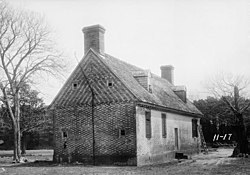Keeling House | |
 View of north and west (rear) facades. Note the unique decorative glazed headers. Image courtesy of Historic American Buildings Survey (HABS). | |
| Location | 3157 Adam Keeling Road, Virginia Beach, Virginia |
|---|---|
| Coordinates | 36°54′2.2″N 76°4′44.8″W / 36.900611°N 76.079111°W |
| Built | circa 1735 |
| Architectural style | Pre-Georgian |
| NRHP reference No. | 73002297[1] |
| VLR No. | 134-0018 |
| Significant dates | |
| Added to NRHP | June 19, 1973 |
| Designated VLR | April 17, 1973[2] |
The Adam Keeling House is a historic house in Virginia Beach, Virginia, United States.
Dendrochronology undertaken by the Oxford Tree-Ring Laboratory revealed that house was constructed of timbers felled in 1734–1735, pointing to a construction date of circa 1735. It is among the oldest surviving houses in Virginia Beach. Situated on Adam Keeling Road in Great Neck Point on the Lynnhaven River, The Keeling House is known for decorative glazed headers and a center hall design, which is common in Tidewater Virginia British colonial architecture.[3]
When built, the house was in rural Princess Anne County, but today the house sits in the middle of a suburban neighborhood. The house is privately owned, though it can be seen from the street. It is the oldest continuously occupied house in Virginia. A cemetery of family graves is north of the intersection of Adam Keeling Road and Lynn Cove Lane.
Through much of the 20th century, the house was known as Ye Dudlies. Other houses from the Virginia colony in Virginia Beach still extant include the Adam Thoroughgood House, Broad Bay Manor, Lynnhaven House, Pembroke Manor, Upper Wolfsnare, and Francis Land House.
- ^ "National Register Information System". National Register of Historic Places. National Park Service. July 9, 2010.
- ^ "Virginia Landmarks Register". Virginia Department of Historic Resources. Archived from the original on 2013-09-21. Retrieved 19 March 2013.
- ^ Virginia Historic Landmarks Commission Staff (February 1973). "National Register of Historic Places Inventory/Nomination: Adam Keeling House" (PDF). Virginia Department of Historic Resources. and Accompanying photo Archived 2012-09-27 at the Wayback Machine

